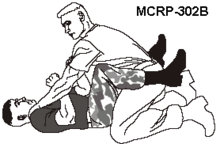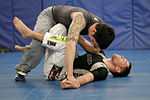- Guard (grappling)
-
Guard A type of open guard, as shown in a USMC combatives manual Classification Position Parent style Brazilian Jiu-Jitsu, Judo AKA Full guard The guard is a ground grappling position where one combatant has their back to the ground, while attempting to control the other combatant using the legs. In pure grappling combat sports, the guard is considered an advantageous position, since the bottom combatant can attack with various joint locks and chokeholds, while the top combatant's priority is to transition into a more dominant position, a process known as passing the guard. In mixed martial arts competition or hand-to-hand combat in general, it is possible to effectively strike from the top in the guard, even though the bottom combatant exerts some control. There are various types of guard, with their own advantages and disadvantages.
The guard is a key part of Brazilian Jiu-Jitsu where it is used as an offensive position. It is also used, but not formally named, in judo[1] though it is sometimes referred to as "dō-osae" in Japanese, meaning "trunk hold".[2][note 1] It is called the "front body scissor" in catch wrestling.
Contents
Pulling Guard
Transitioning directly from standing to the guard position is known as pulling guard. Tsunetane Oda, a judo groundwork specialist who died in 1955,[3] demonstrated the technique on video.[4]
Closed Guard
Sometimes referred to as full guard. The closed guard is the typical guard position. The legs are hooked behind the back of the opponent, preventing them from standing up or moving away. The opponent needs to open the legs up to be able to improve positioning. The bottom combatant might transition between the open and closed guard, as the open guard allows for better movement, but also increased risk in the opponent passing the guard.
Open Guard
The open guard is typically used to perform various joint locks and chokeholds. The legs can be used to move the opponent, and to create leverage. The legs open allows the opponent to stand up or try to pass the guard, so this position is often used temporarily to set up sweeps or other techniques. Open guard is also a general term that encompasses a large number of guard positions where the legs are used to push, wrap or hook the opponent without locking the ankles together around them.
Butterfly Guard
The butterfly guard involves both of the legs being hooked with the ankles in between the opponents legs, against the inside of the opponents thighs. The opponent is controlled using both legs and arms. The butterfly guard is often short-lived since the opponent might be able to move quite freely. The leverage in the butterfly guard allows for powerful sweeps. The butterfly guard also allows one to elevate or set the opponent off balance, because of this it is particularly useful in avoiding damage from ground and pound and for many transitions.
X-Guard
The x-guard is an open guard where one of the combatants is standing up and the other is on their back. The bottom combatant uses the legs to entangle one of the opponent's legs, which creates opportunities for powerful sweeps. The x-guard is often used in combination with butterfly and half guard. In a grappling match, this is an advantageous position for the bottom combatant, but in general hand-to-hand combat, the top combatant can attack with stomps or soccer kicks. This having been said, skilled use of the X guard can prevent the opponent from attempting a kick, or throw them off balance should they raise a leg. The X-guard was popularised by Marcelo Garcia.[5]
Spider Guard
The spider guard comprises a number of positions all of which involve controlling the opponents arms while using the soles of the feet to control the opponent at the biceps, hips, thighs or a combination of them. It is most effective when the sleeves of the opponent can be grabbed, for instance if the opponent is wearing a gi. The spider guard can be used for sweeps and to set up joint locks or chokeholds.
De la Riva Guard
 The De la Riva guard being used in Brazilian Jiu-Jitsu training
The De la Riva guard being used in Brazilian Jiu-Jitsu training
The De la Riva guard (also called the De la Riva hook and jello guard) is an open guard that was popularized in Brazilian Jiu-Jitsu by black belt Ricardo de la Riva Goded, who was successful with it in competition.[citation needed] In it, one of the legs is wrapped behind the opponent's leg from the outside, the ankle held with one hand, and the other hand grips one of their sleeves. The De la Riva guard offers many sweeps, transitions and submissions, and is often used in combination with spider guard.
Rubber Guard
Main article: Rubber guardThis is a position that keeps the opponent down in your guard. First used by Nino Schembri but popularized and made a system by Eddie Bravo, many techniques have been developed from this position including sweeps, submissions, and striking defense. By being flexible and using a leg to hold the opponent down, one arm is free to work on submissions, sweeps or to strike the opponent's trapped head.
50-50 Guard
The 50-50 (Fifty-fifty) guard is a position popularized by Roberto “Gordo” Correa and extensively used by the Mendes Brothers, Rafael and Guilherme Mendes, Bruno Frazzato, and Ramon Lemos from the Atos Jiu Jitsu Team. In other grappling systems such as catch wrestling and Russian Sambo, it is a form of the "outside leg triangle" type of leg control. In this position, the fighter on the bottom crosses a triangle on the opponent's leg, which allows for the leg to be dominated while leaving the arms free to work on sweeps and submissions. This position has been heavily criticized for use in competitions with restricted use of leglocks due to the potential of stalling a match when the fighter on top cannot pass the guard and the fighter on the bottom cannot successfully perform a sweep.[6][7][8][9][10][11][12]
Passing the Guard
In order to overcome the primary defense of his opponent, his guard, and attain a more dominant position, such as side mount, full mount, or knee on stomach a practitioner must pass the guard. There are several ways of doing so; many involve pain compliance whereby the practitioner persuades the opponent to release his guard through an abrasive action. Examples of this type of action would be digging the practitioner's forearms into the inner thigh of the opponent, standing and attempting a can opener neck crank, or in the case of a mixed martial arts setting, to simply strike the opponent until the guard is released. Passing the guard however has perils of its own, as it has a tendency to leave the practitioner particularly vulnerable to counter attack in the form of sweeps and submissions.
See also
Footnotes
References
- ^ Jimmy Pedro. The Pedro Guard Pass by Jimmy Pedro
- ^ Miller, Chris. Grappling/Submission Fighting. hsma1.com. URL last accessed on March 4, 2006.
- ^ Toshikazu Okada. Master Tsunetane Oda
- ^ Tsunetane Oda - judo ne-waza 2 of 3
- ^ http://books.google.com.my/books?id=xdahTKqjYDEC&pg=PA23&lpg=PA23&dq=x+guard+marcelo+garcia&source=bl&ots=ELNX1HCoMP&sig=YdyAgHI7K1sULSrrBeUei9kkEDs&hl=en&ei=RXGNSuGHGZng7APomd3ACg&sa=X&oi=book_result&ct=result&resnum=5#v=onepage&q=&f=false
- ^ http://www.tatame.com.br/2009/08/02/A-polemica-guarda-50-50-na-TATAME-162
- ^ http://www.tatame.com.br/2009/08/04/Comprido-defende-a-polemica-guarda-50-50
- ^ http://www.tatame.com.br/2009/08/07/Romero-Jacare-e-a-guarda-50-50
- ^ http://www.tatame.com.br/2009/08/22/Checkmat-e-a-saida-da-guarda-5050
- ^ http://www.tatame.com.br/2009/08/23/Mendes-e-Frazzato-defendem-a-Guarda-5050
- ^ http://www.tatame.com.br/2009/08/26/Esquisito-condena-a-guarda-50-50
- ^ http://www.tatame.com.br/2009/09/01/Irmaos-Mendes-rebatem-defesas-a-50-50
Further reading
- Løvstad, Jakob. The Mixed Martial Arts Primer. www.idi.ntnu.no. URL last accessed March 6, 2006. (DOC format)
- Page, Nicky. Groundfighting 101. homepage.ntlworld.com. URL last accessed March 4, 2006.
- Kesting, Stephan. The X guard position. www.grapplearts.com. URL last accessed March 7, 2006.
- Bravo, Eddie (2006) Mastering The Rubber Guard. ISBN 0-9777-3159-6
Grappling Grappling Based Martial Arts Aikido · Brazilian Jiu-Jitsu · Catch Wrestling · Chin Na · Glima · Judo · Jujutsu · Kinomichi · Kurash · Luta Livre Esportiva · Malla-yuddha · Mongolian wrestling · Pahlavani · Pehlwani · Sambo · Shoot wrestling · Shuai Jiao · Ssireum · Sumo · Wrestling · Yağlı Güreş · JujutsuGeneral Techniques Bridge · Collar tie · Eye-gouging · Fish-hooking · Holds · Hooks · Ippon Seoinage · Muay Thai clinch · Nelson hold · Overhook · Small joint manipulation · Stacking · Sprawl · Sweep · Takedown · Transition · UnderhookGrappling positions Back mount · Clinch fighting · Collar-and-elbow position · Cradle · Crucifix position · Guard · Half guard · Harness · Knee-on-stomach · Mount · North-south position · Over-under position · Pinch grip tie · Side controlSubmission types Organisations ADCC Submission Wrestling World Championship · Mundials · International Federation of Associated Wrestling Styles · North American Grappling Association · Grapplers QuestCategories:- Grappling positions
- Brazilian Jiu-Jitsu
Wikimedia Foundation. 2010.







